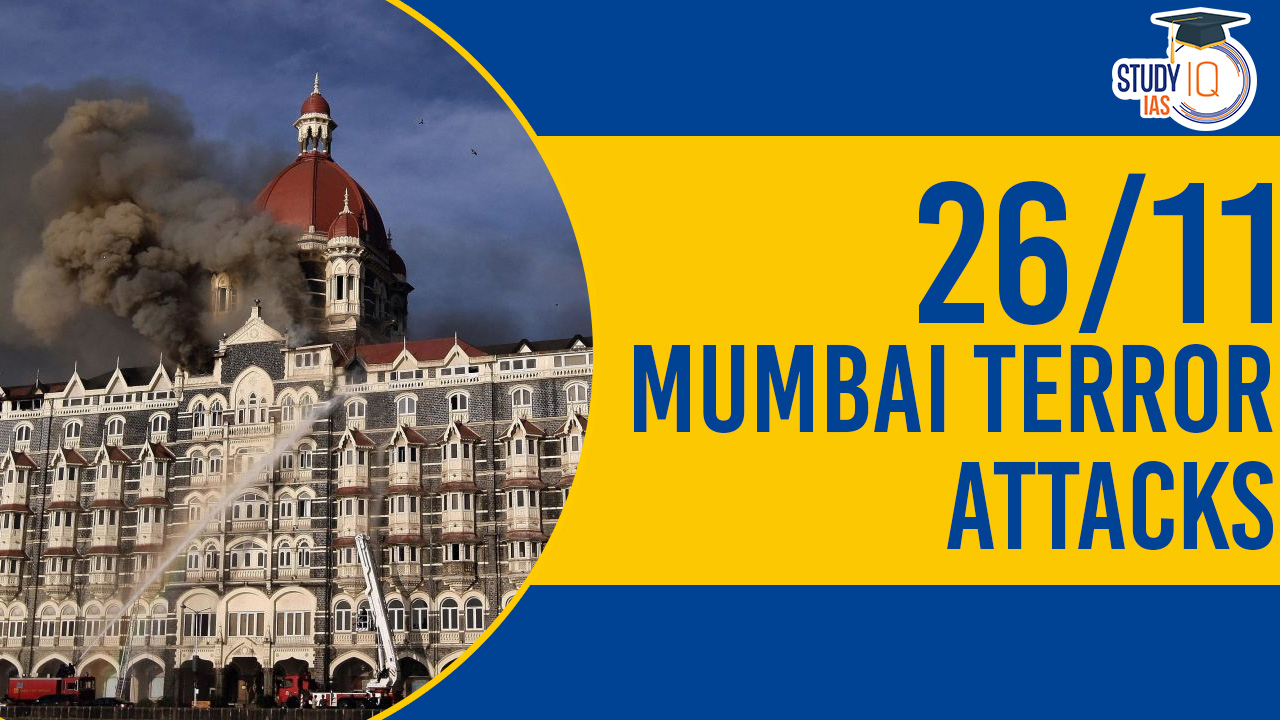Table of Contents
November 26, 2024, marks the 16th anniversary of the devastating 26/11 Mumbai terror attacks—a series of coordinated assaults that left an indelible scar on India and the world. On this day in 2008, ten heavily armed Lashkar-e-Taiba (LeT) terrorists unleashed terror across Mumbai, claiming 166 lives and injuring over 300. The tragedy is not just a reminder of the cost of terrorism but also a testament to the resilience and bravery of individuals who stood up in the face of terror.
26/11 Mumbai Terror Attack: Historical Context
- Background and Timeline: The Mumbai Terror Attacks, which occurred from November 26-29, 2008, were carried out by 10 gunmen linked to the Pakistan-based terrorist group Lashkar-e-Taiba. They targeted multiple locations in Mumbai, including the Chhatrapati Shivaji railway station, the Taj Mahal Palace & Tower, and the Oberoi Trident Hotel.
- Casualties and Key Events: The attacks resulted in at least 174 deaths, including 20 security personnel and 26 foreign nationals, and over 300 were injured. The standoff ended with most terrorists killed and one arrested.
Timeline of 26/11 Mumbai Terror Attack
November 26
- 9:00 PM: Four armed men enter the Chhatrapati Shivaji Terminus (CST) railway station and open fire indiscriminately.
- 9:15 PM: Two armed men enter the Leopold Cafe and open fire on patrons.
- 9:30 PM: Two armed men enter the Cama Hospital and open fire on staff and patients.
- 10:00 PM: Two armed men enter the Nariman House, a Jewish community centre, and take hostages.
- 10:30 PM: Armed men enter the Oberoi Trident and Taj Mahal Palace hotels and open fire on guests and staff.
Aftermath of the 26/11 Mumbai Terror Attack
The 26/11 Mumbai terror attacks were a major blow to India’s national security. The attacks also caused widespread fear and anxiety among the Indian population. In the aftermath of the attacks, the Indian government took a number of steps to improve its security measures. These included:
- Strengthening border security
- Improving intelligence gathering
- Establishing a new anti-terrorism agency
Issues with Security Infrastructure in India
- Lack of Coordination Between Different Agencies: There was a lack of effective coordination between India’s various intelligence and security agencies, which often led to a failure to share critical information.
- Inadequate Intelligence Gathering: India’s intelligence agencies were not able to gather sufficient information about the threat of terrorism, and there was a lack of awareness of the specific plans of the Lashkar-e-Taiba (LeT) group that carried out the 26/11 attacks.
- Poor Coastal Security: India’s coastline was poorly guarded, and there were a number of gaps in the country’s maritime security system. This allowed the LeT terrorists to infiltrate India by sea.
- Inadequate Infrastructure: India’s security infrastructure was not well-equipped to deal with a major terrorist attack. There was a shortage of trained personnel, and there were not enough resources available to respond to the attack.
Security Infrastructure After 26/11 Attack
Maritime Security Enhancements
The Indian Navy took over maritime security, coordinating with the Indian Coast Guard and new marine police stations along the coastline. The Sagar Prahari Bal division was formed for patrol and rescue operations, and the Automatic Identification System (AIS) was mandated for larger vessels. Additionally, extensive coastal defence exercises like Sea Vigil were initiated.
Improved Coordination and Response
- Amendment to the Unlawful Activities Prevention Act (UAPA): This amendment broadened the legal definition of terrorism, enhancing the legislative tools available to combat and prosecute terrorist activities. By expanding the scope of what constitutes terrorism, the law aimed to cover a wider range of activities and groups involved in such acts.
- Establishment of the National Investigation Agency (NIA) Act: The creation of the NIA marked a significant shift towards a centralised approach to investigating and prosecuting terrorism-related cases. This federal agency was empowered to take over the investigation of terror cases across states, bypassing state jurisdictions, to ensure a more coordinated and effective response to terrorism.
- Multi-Agency Centre (MAC): NSG hubs were set up across different states for rapid response, and the Intelligence Bureau’s Multi-Agency Centre (MAC) was strengthened for better intelligence sharing and analysis.
Modernisation of Police Forces
The focus on modernising police forces included several aspects:
- Upgrading Police Stations: Implementing state-of-the-art facilities and technologies in police stations to enhance operational capabilities.
- Introducing Modern Technology: Equipping police forces with advanced technology for intelligence gathering, surveillance, and analysis.
- Training in Modern Policing Techniques: Specialised training programs were introduced to prepare police personnel for contemporary challenges, including terrorism.
- Enhanced Weaponry: Providing better, more effective weapons to police forces.
- Creation of Crack Commando Teams: These specialised teams were established to respond swiftly and effectively to terrorist threats and incidents.
- NSG Regional Hubs: The establishment of NSG regional hubs aimed to ensure rapid deployment and response capabilities across the country.
Increased Western Cooperation
Post-26/11, there was a significant improvement in intelligence-sharing and security collaboration with Western countries, particularly the United States (like the FBI). This cooperation played a crucial role in countering terrorism and led to significant arrests and actionable intelligence sharing.
Isolation of Pakistan on the International Stage
The diplomatic efforts to highlight Pakistan’s role in sponsoring terrorism led to its inclusion in the FATF’s grey list. This international pressure was aimed at compelling Pakistan to dismantle the terror infrastructure operating from its territory.
Conclusion
The 26/11 attacks were a tragedy that claimed the lives of many innocent people. However, they also served as a wake-up call for India and the world about the threat of terrorism. India has taken a number of steps to improve its security infrastructure and strengthen its ties with other countries in the region. The United States has also increased its cooperation with India on counterterrorism.


 Africa’s Nuclear Energy Market Status ...
Africa’s Nuclear Energy Market Status ...
 International Laws on Immigrants Right t...
International Laws on Immigrants Right t...
 SQUAD Grouping of USA, Key Members and I...
SQUAD Grouping of USA, Key Members and I...





















